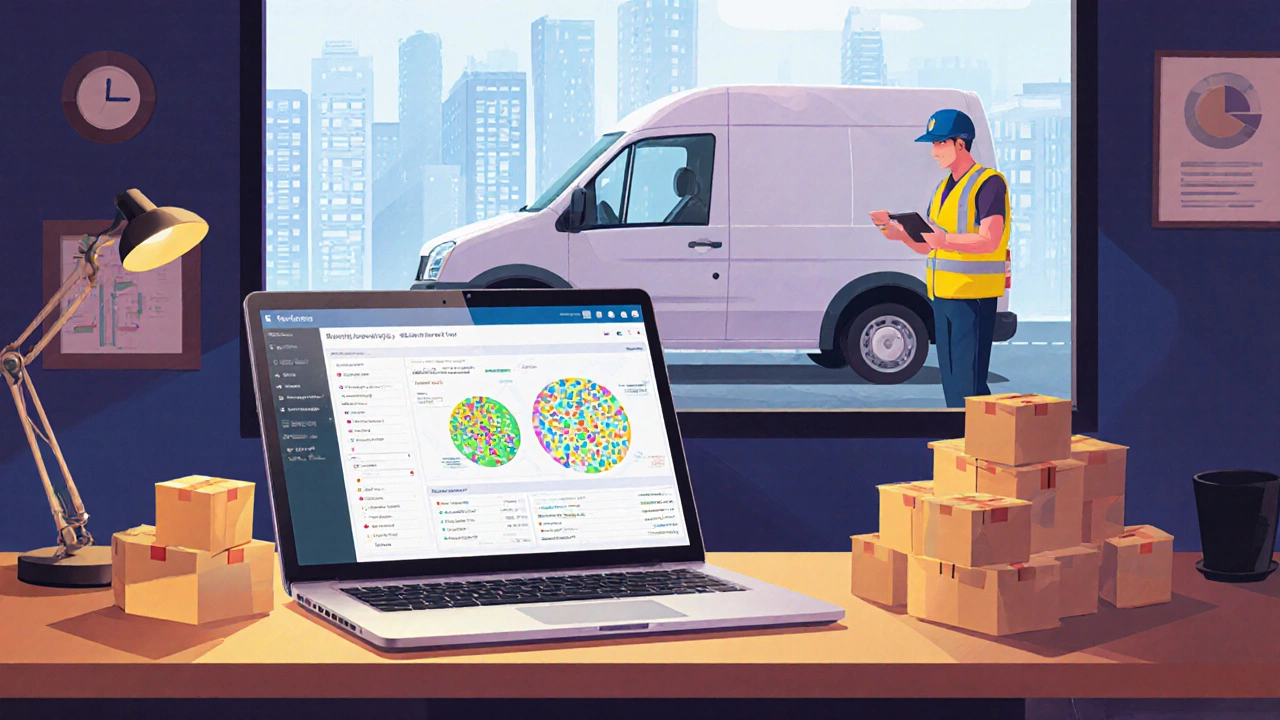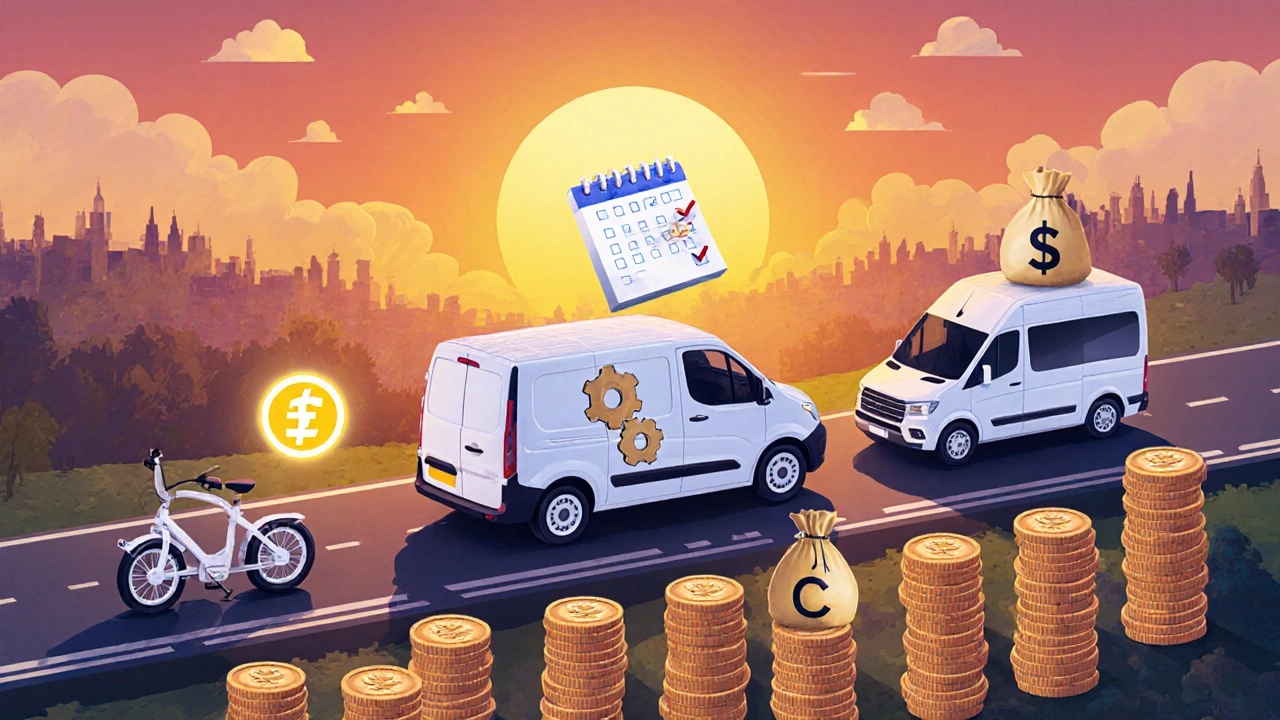Delivery Business Profit Calculator
Business Inputs
Startup Costs
Profitability Results
Monthly Revenue
Monthly Costs
Monthly Profit
Break-Even Analysis
At your current rate, you'll break even in months.
With your target of months, you'll need a monthly profit of £ to reach that goal.
Profitability Status
Seeing more and more people order groceries, electronics, and even farm‑fresh produce straight to their doors, you might wonder if launching a delivery business is the next smart move. The question isn’t just about cash flow - it’s about whether the market, regulations, and technology line up for a new player to thrive. Below we break down the real‑world numbers, legal steps, and operational choices you’ll face in the UK in 2025.
Market Landscape: Why 2025 Feels Different
According to the Office for National Statistics, same‑day and next‑day deliveries grew by 14% year‑on‑year in 2024, reaching a £12billion market in the UK alone. That surge is driven by three forces:
- Consumer expectations for ultra‑fast, trackable shipments.
- Retailers expanding omnichannel fulfillment, especially in urban centres.
- Improved routing software that squeezes more stops into each driver’s shift.
Courier service is a business that transports parcels or documents from a sender to a receiver, typically on a short‑distance, time‑critical basis. In cities like Bristol, the density of e‑commerce orders means a single van can handle 60‑80 stops per day, a figure that was impossible a decade ago.
Financial Realities: Startup Costs You Can’t Ignore
Before you hit the road, calculate the cash you’ll need up front. The biggest expense buckets are:
- Vehicle acquisition - a new electric cargo bike runs around £2,200, while a midsize van costs £25,000-£30,000.
- Licensing & permits - you’ll need a courier licence (authorisation from the DVLA to operate commercial vehicles for goods transport), which costs roughly £150 per vehicle.
- Insurance - public liability and vehicle insurance together average £1,200 per year for a van, £300 for a bike.
- Technology stack - routing software, a basic order‑management system and a smartphone upgrade typically add up to £800-£1,200 upfront.
- Operating capital - fuel (or electricity), driver wages, and maintenance. For a single van, expect £3,500-£4,500 per month.
Summing these, a lean bike‑based operation can launch under £5,000, whereas a fully‑equipped van service may need £40,000-£50,000 before the first invoice hits.
Revenue Streams & Profitability
How do you actually make money? Most UK couriers charge per‑kilometre plus a handling fee. The typical price points in 2025 are:
- Bike delivery: £3.50‑£4.00 per kilometre, plus £1‑£2 per parcel.
- Van delivery: £5.00‑£6.50 per kilometre, plus £2‑£3 per parcel.
- Premium “same‑day” service: surcharge of 20‑30% on base rates.
Industry data from the Freight Transport Association shows average gross profit margins of 12% for bike couriers and 9% for van‑based services. The gap comes from higher fuel and maintenance costs for larger vehicles. However, a van can carry 10‑15 times the volume of a bike, so total profit can still be higher if you secure enough contracts.

Legal & Compliance Checklist
Running a lawful delivery business in the UK means ticking several boxes:
- Business registration (incorporating as a limited company or sole trader with Companies House).
- Vehicle registration (ensuring each commercial vehicle is listed with the DVLA).
- Compliance with the EU Package Travel Regulations for cross‑border shipments, even post‑Brexit.
- Data protection - GDPR compliance for any customer address data you store.
- Health & safety risk assessments for drivers, especially if you employ anyone under 25.
Missing any of these can trigger fines up to £20,000 per breach, so treat compliance as a non‑negotiable cost.
Technology & Operations: Automating the Hustle
Modern routing platforms like OptimoRoute (software that optimises delivery sequences to reduce distance and time) can boost efficiency by 15‑20%. Pair that with a simple API that pulls orders from e‑commerce platforms (Shopify, WooCommerce) and you’ll spend less time on spreadsheets and more on deliveries.
Key tech components to consider:
- Real‑time GPS tracking for customers (adds trust and upsell potential).
- Digital proof‑of‑delivery signatures.
- Automated invoicing linked to mileage logs.
Investing in a solid tech stack may raise your initial spend by £1,000‑£2,000, but the resulting productivity gains often pay for themselves in the first six months.
Risk Management: Insurance & Contingency Planning
Even with the best drivers, accidents happen.
Delivery insurance (covers loss or damage to parcels, vehicle liability, and driver injury) typically includes:
- Public liability - up to £10million cover for third‑party claims.
- Goods in transit - average £1,500 per claim for small parcels, £5,000 for heavier items.
- Vehicle damage - comprehensive cover with a £250 excess per incident.
Run a “what‑if” scenario: a single van accident that results in £8,000 in damages and a £2,000 claim from a customer. Without insurance, that could wipe out a month’s profit.

Decision Framework: Is It Worth It?
Use this quick matrix to judge your situation:
| Model | Initial Investment | Monthly Operating Cost | Average Gross Margin | Best Use‑Case |
|---|---|---|---|---|
| Bike Courier | £4,500 | £1,200 | 12% | Urban, high‑density orders (food, small parcels) |
| Van‑Based Local | £42,000 | £4,200 | 9% | Mixed‑size parcels, suburban routes |
| Fleet (5+ Vans) | £220,000 | £21,000 | 8% | Retailer contracts, multi‑city coverage |
If you have limited capital but can secure a steady flow of small orders, the bike model offers the fastest break‑even (about 4‑5 months). Larger investments require solid contracts-often from local retailers or third‑party logistics providers-to avoid cash‑flow gaps.
Finally, ask yourself three questions:
- Do I have access to a reliable vehicle fleet or can I lease affordably?
- Is there a clear demand niche (e.g., next‑day grocery) that larger players haven’t saturated?
- Can I manage the regulatory and insurance overhead without hiring a full‑time compliance officer?
Answering “yes” to all three suggests a green light. If you’re hesitant on any, consider starting with a single bike or partnering with an existing platform to test the market first.
Quick Takeaways
- The UK last‑mile market grew 14% in 2024, offering fresh demand for small operators.
- Initial capital ranges from £5k (bike) to £50k (single van) to £220k (fleet).
- Gross margins sit between 8‑12%; volume and efficiency are the profit levers.
- Compliance (licensing, insurance, GDPR) adds fixed costs but protects against costly penalties.
- Investing in routing software can shave 15‑20% off travel time, boosting revenue per driver.
Frequently Asked Questions
What is the minimum capital required to start a delivery business in the UK?
For a single‑bike operation you can launch with around £4,500‑£5,000, covering the bike, basic tech, insurance and a modest marketing budget. A van‑based start typically needs £40,000‑£50,000 to cover vehicle purchase, licensing and the first few months of operating expenses.
Do I need a special courier licence to operate a bike?
If the bike is used purely for non‑commercial personal transport, no licence is required. For a commercial courier service you must register the bike with the DVLA and pay the standard £150 vehicle‑licensing fee, even though it’s a two‑wheeler.
How much can I charge per delivery in a city like Bristol?
Typical rates in 2025 are £3.50‑£4.00 per kilometre plus £1‑£2 per parcel for bike deliveries. Van services charge £5.00‑£6.50 per kilometre and £2‑£3 per parcel. Premium same‑day slots add a 20‑30% surcharge.
Is it better to lease or buy a delivery van?
Leasing reduces upfront cash outlay and includes maintenance, making it attractive for first‑time owners. Buying gives you asset equity and lower long‑term costs if you plan to keep the vehicle for more than five years. Run a break‑even analysis based on your projected mileage to decide.
What insurance coverage is essential for a new courier?
At a minimum you need public liability (≥ £10million), goods‑in‑transit cover for the value of parcels you handle, and comprehensive vehicle insurance. Many brokers offer bundled policies starting around £300 per year for a bike and £1,200 for a van.





